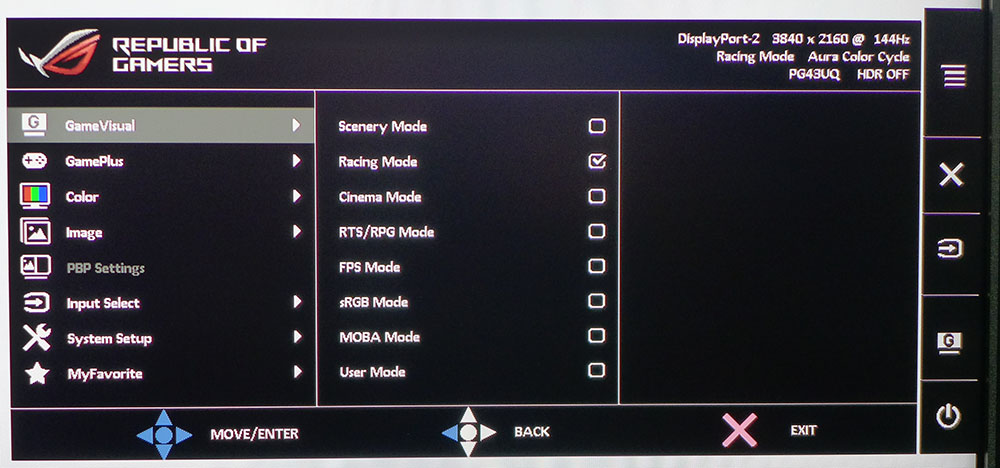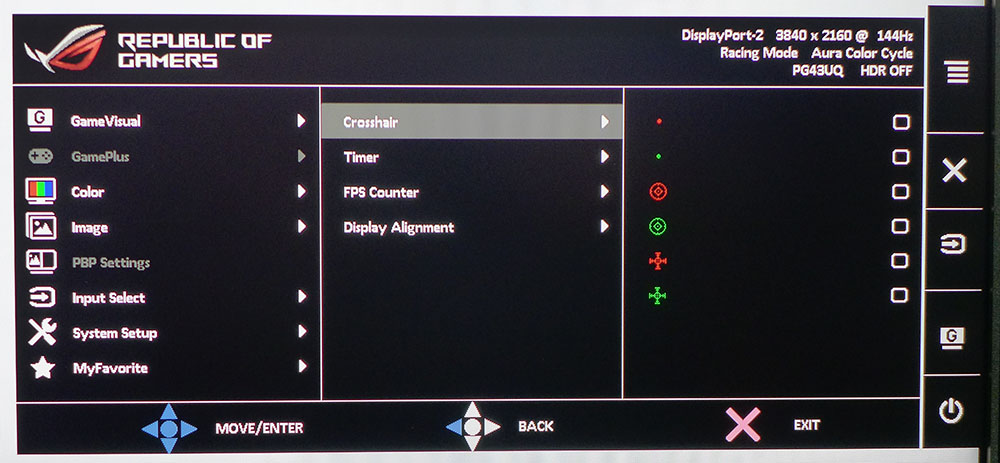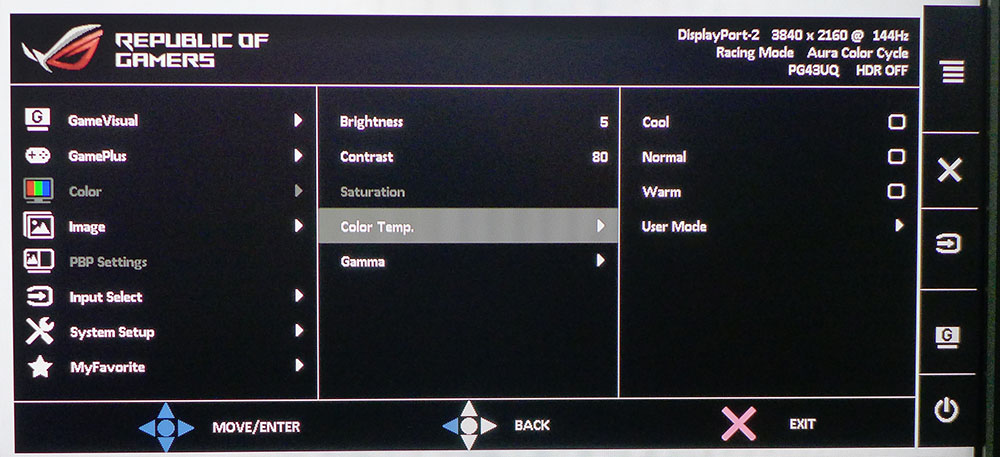Tom's Hardware Verdict
As a gaming monitor, the Asus ROG Swift PG43UQ has few equals in the large format category. Its excellent contrast, vibrant and accurate color and smooth video processing make gaming addictive. You won’t find a more immersive way to play unless you spend considerably more money on an even larger screen.
Pros
- +
FreeSync and G-Sync Compatible
- +
90% DCI-P3 color coverage
- +
Killer HDR
- +
Handy remote
- +
Solid build quality
Cons
- -
Too bright for darkly lit rooms
- -
No 24p film mode for Blu-ray movies
Why you can trust Tom's Hardware
When it comes to gaming monitors, going big requires a big investment from your wallet. The 43-inch Asus ROG Swift PG43UQ is not only large, it’s also a high-end gaming monitor that promises premium HDR images with a minimum max brightness certified to reach a whopping 1,000 nits. And that backlight includes an effective dynamic contrast option that works equally well for SDR and HDR. Now that’s something to get excited about.
At $1,500 as of writing, the ROG Swift PG43UQ could give one a sense of sticker shock. But considering the 144 Hz refresh rate and inclusion of both Nvidia G-Sync Compatibility and AMD FreeSync, plus fantastic HDR image quality, this is one the best 4K gaming monitors to start saving up for.
Asus ROG Swift PG43UQ Specs
| Panel Type / Backlight | VA / W-LED, edge array |
|---|---|
| Screen Size / Aspect Ratio | 43 inches / 16:9 |
| Max Resolution & Refresh Rate | 3840x2160 @ 144Hz; G-Sync Compatible: 48-120 Hz; FreeSync: 30-144 Hz |
| Native Color Depth & Gamut | 10-bit (8-bit+FRC) / DCI-P3; HDR10, DisplayHDR 1000 |
| Response Time (GTG) | 1ms |
| Brightness | SDR: 750 nits; HDR: 1,000 nits |
| Contrast | 4,000:1 |
| Speakers | 2x 10w |
| Video Inputs | 2x DisplayPort 1.4. 2x HDMI 2.0 |
| Audio | 3.5mm analog input, 3.5mm headphone output |
| USB 3.0 | 1x up, 2x down |
| Power Consumption | 53w, brightness @ 200 nits |
| Panel Dimensions | 38.4 x 24.8 x 9.5 inches |
| WxHxD w/base | (975 x 631 x 242mm) |
| Panel Thickness | 3 inches (76mm) |
| Bezel Width | Top/sides: 0.6 inch (15mm), Bottom: 0.9 inch (23mm) |
| Weight | 33.7 pounds (15.3kg) |
| Warranty | 3 years |
Asus starts with a VA panel that has one of the highest native contrast ratios we’ve come across. FreeSync is the native adaptive refresh tech, but Nvidia has certified the PG43UQ as G-Sync Compatible. This means you can enjoy 4K HDR gaming with your best graphics cards in either Nvidia or AMD flavors with screen tearing-fighting tech.
The Asus ROG Swift PG43UQ introduces a display stream compression (DSC) feature. As part of the DisplayPort 1.4 interface, it allows full-bandwidth signals of up to 10-bits across a single DisplayPort cable. This eliminates any need for chroma subsampling, which can sometimes cause banding. In monitors without this technology, high bandwidth content must be compressed before transmission, leaving the display to fill in the gaps. DSC lets your video card and monitor communicate so they can compress the signal more efficiently and eliminate color sampling errors. The result is better picture quality.
Unpacking / Accessories for ROG Swift PG43UQ
The Asus ROG Swift PG43UQ arrived in our lab with a two-person lift sticker attached. It wasn’t that heavy, but the carton is large. It comes apart like a TV box to reveal a panel already assembled with a tabletop stand. A 43-inch screen is closer in size to a TV than a standard PC monitor, and you should think hard before putting one on top of a desk. If you do, we suggest at least a 4-foot viewing distance.
The accessory bundle includes an ROG logo LED projector, a cover for the input panel, HDMI, DisplayPort, audio and USB cables and, surprisingly, a large external power supply. The best part, however, is the tiny remote control, which is a necessity when sitting far back from a monitor.
Product 360 of Asus ROG Swift PG43UQ
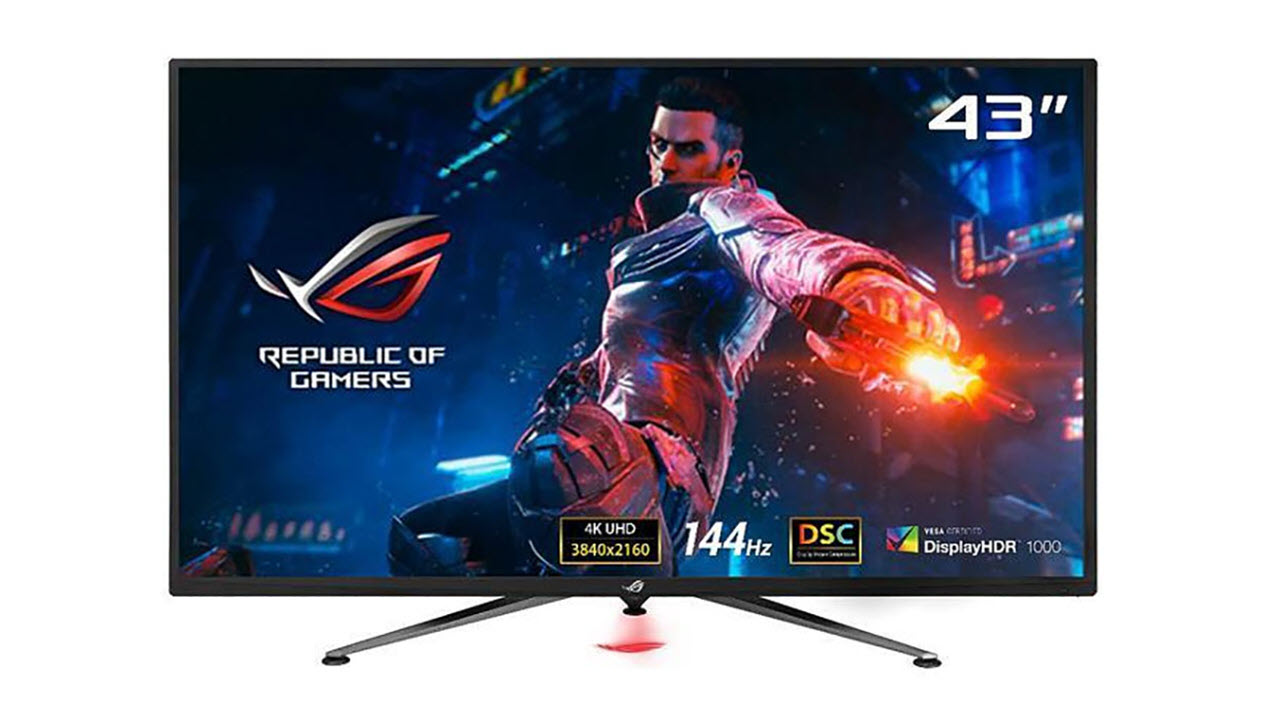
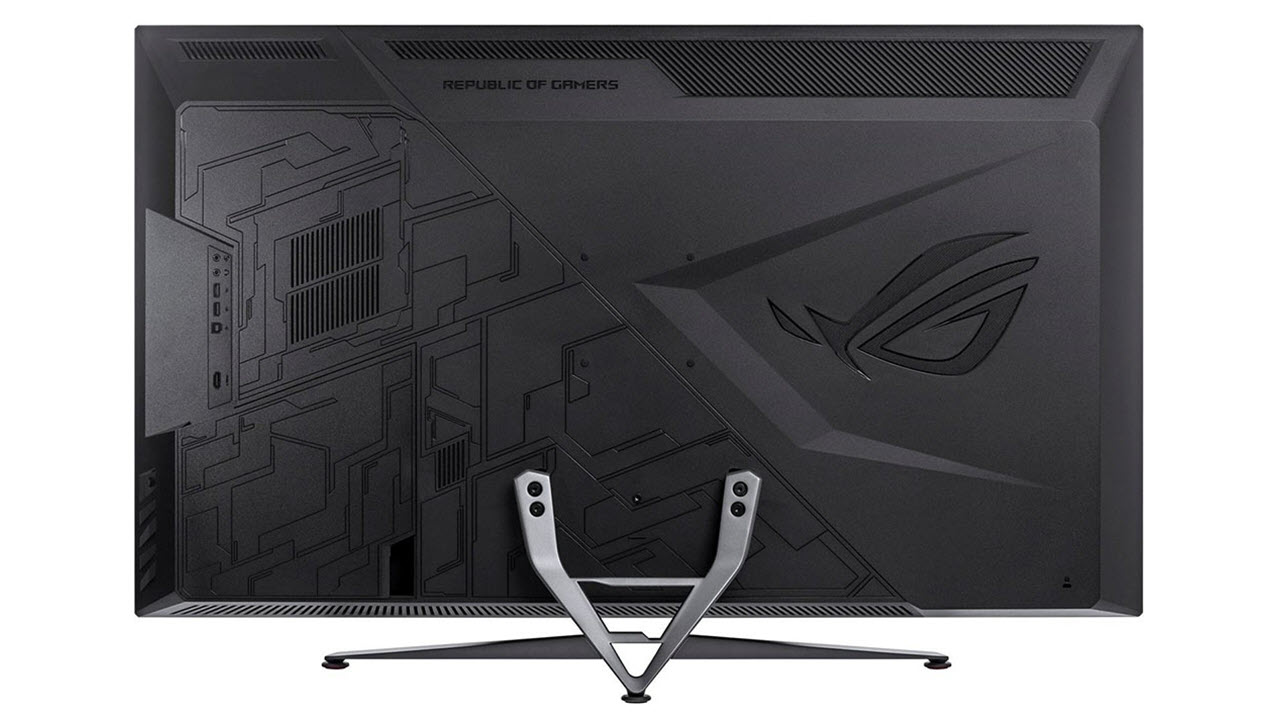
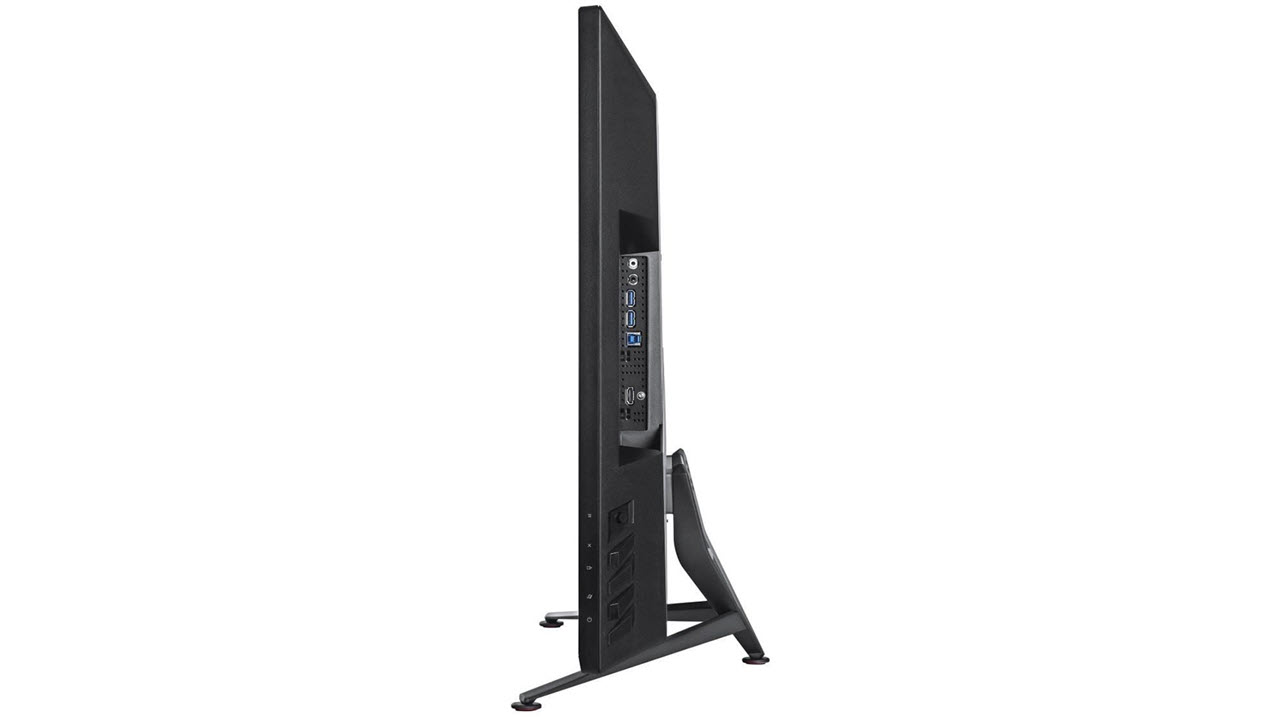
As part of Asus’ Republic of Gamers (ROG) line, the PG43UQ sports styling befitting a premium gaming monitor and RGB lighting. The RGB comes in the form of a small lipstick-style that projects the ROG logo onto your desk, ceiling, wall or wherever else you point it. The projector connects with a short USB cable and uses Asus’ Aura RGB technology. You can control the logo’s color and effect from the on-screen display (OSD), and with the Asus Aura Sync software, you can coordinate the color and effects of the ROG logo with other compatible Aura Sync-compatible parts, like RAM and motherboards.
Get Tom's Hardware's best news and in-depth reviews, straight to your inbox.
From the front, the ROG Swift PG43UQ reads ‘television,’ and it’s certainly large enough to be one in a small room. Its front bezel is prominent, and the panel sits on a sturdy stand with a moderately large footprint. Ergonomic adjustments are tilt, 10 degrees back and 5 degrees forward. If you’d rather wall-mount, the monitor comes with 100mm VESA fittings. The ROG Swift PG43UQ has an effective anti-glare layer that makes it suitable for just about any space, and our testing will show that there’s more than enough brightness to compete with sunlit windows.
Around back are two input panels, one facing down and the other along the right side. The latter has two USB downstream ports and one upstream along with 3.5mm audio in/out and an HDMI 2.0 input. On the bottom is the remaining HDMI 2.0 and two DisplayPort 1.4 connectors (we compare the two in our DisplayPort vs HDMI article.
The external power brick is quite large, but it has a long cord so it should be easy to hide in an equipment rack. There are two 10-watt speakers built into the ROG Swift PG43UQ. Their extra size and power mean a bit larger frequency range than most, and they play at a reasonably loud volume without distortion.
OSD control happens two ways: with a set of large buttons and a joystick on the panel’s back right side or via a slick little remote. In a thoughtful touch, the menu that comes up when you use the remote is large enough to be read from across the room while the button-controlled menu is smaller -- nice attention to detail. The remote is well made and never missed a beat during our tests. We could rip through the extensive menu system with ease.
OSD Features of Asus ROG Swift PG43UQ
The OSD will be familiar to Asus users and includes every feature a gamer or entertainment enthusiast could want. With a few tweaks, the ROG Swift PG43UQ is ready to serve multiple duties as a gaming display, movie machine or general computer monitor.
GameVisual is Asus’ term for picture modes, and the menu has 9 presets tailored for specific game types. As usual, the default is Racing, and it was reasonably accurate out of the box. It can be calibrated for better performance in SDR mode. When HDR signals are present, most image controls are locked out, but you get three HDR image presets and can dial back the peak brightness to 600 or 400 nits.
The ROG Swift PG43UQ has Asus’ standard suite of GamePlus features with a selection of aiming points, countdown timers, a frame rate counter and display alignment marks for multi-screen configurations.
For calibration, there are three Color Temp presets, including a User mode with RGB sliders. The User picture mode unlocks the color saturation slider, but we found no need for it since the ROG Swift PG43UQ’s gamut accuracy is quite good by default. There are also three gamma presets, 1.8, 2.2 and 2.5.
The Image menu holds a five-level overdrive, but the third one is as high as you can go before seeing ghosting. You also get motion blur reduction in the form of a backlight strobe, which works up to the max refresh rate of 144 Hz and has a five-click setting that reduces blur and brightness with its variable pulse width. You can also toggle Adaptive-Sync on and off here.
Buried in the second screen of the Image menu are the HDR modes and HDR Max Brightness options. In our tests, we found only subtle differences between the three presets. GamingHDR is the default and our preference. The Max Brightness option lists 1,000, 600 and 400 nits, but we found that 600 and 400-nit settings provided around 700 nits of max brightness.
Also here is perhaps the most important image control of all on the Asus ROG Swift PG43UQ, Dynamic Dimming. This is the backlight’s dynamic contrast feature, and it worked extremely well at increasing contrast with no apparent clipping. Highlight and shadow detail was preserved beautifully. Dynamic Dimming is automatically locked on when you enter HDR mode. The only flaw is that it grays out the brightness control, and so SDR content looks searingly bright for SDR content. SDR will still look fine with Dynamic Dimming if you’re sitting more than 5 feet from the V, but up close, it became tiring after a few hours of fragging.
Setup / Calibration of Asus ROG Swift PG43UQ
It’s easy to calibrate the Asus ROG Swift PG43UQ in either the User or Racing Game visual modes. Out of the box, color and gamma were nearly spot on, but grayscale needed some tweaking.
After a few changes to the RGB sliders, we achieved reference-level performance. We did our calibration with Dynamic Dimming off. Thankfully, once we turned Dynamic Dimming on, there was no change to gamma. We recommend using Dynamic Dimming, if you can live with the super-bright picture because it nearly triples contrast. Below are the settings we used in SDR mode.
| Picture Mode | User | Header Cell - Column 2 |
|---|---|---|
| Brightness 200 nits | 5 | Row 0 - Cell 2 |
| Minimum brightness | 165 nits | Row 1 - Cell 2 |
| Contrast | 80 | Row 2 - Cell 2 |
| Gamma | 2.2 | Row 3 - Cell 2 |
| Color Temp User | Red 94, Green 98, Blue 100 | Row 4 - Cell 2 |
For HDR signals, you can choose between Cinema, Gaming (the default) and Console picture modes. The three look similar, and we found only minor differences in our measurements. The ROG Swift PG43UQ has 1,000, 600 and 400 nit settings for controlling max brightness with HDR, but the 600 and 400 settings are both around 700 nits as measured.
Gaming / Hands-on with Asus ROG Swift PG43UQ
The first decision you must make when setting up the ROG Switft PG43UQ is whether or not to use its Dynamic Dimming feature. On one hand, it almost triples contrast and provides super-low black levels. On the other hand, it locks brightness to over 800 nits, making the image really bright.
When playing games, Dynamic Dimming made scenery much more realistic. For video and graphics, it will come down to user preference and environment. Watching a movie in a darkened room was fatiguing with Dynamic Dimming on but more palatable if a few lights were on. And if it was an especially dark film, Dynamic Dimming really enhanced the picture with deep blacks and excellent contrast.
For Windows tasks, however, Dynamic Dimming was way too bright. Apps with white backgrounds, like Word or Excel, quickly became tiring to use.
In HDR mode, Windows looked about the same as it did in SDR mode. We tweaked brightness with a slider in the Windows 10 Control Panel, but it didn’t do much to improve the look of productivity apps. But load up an Ultra HD Blu-ray, and you’ll see the ROG Swift PG43UQ’s value. It delivers killer HDR with some of the best contrast we’ve seen outside of a monitor with a FALD backlight, like the Asus ROG Swift PG27UQ, or an OLED panel, like the Alienware AW5520QF
To test and enjoy the ROG Swift PG43UQ’s HDR capabilities, we spent hours playing Call of Duty: WWII, which uses HDR and extended color to its full effect. One scene in particular impressed us. It was when the main character has a conversation with a Nazi officer in an office lit only by a fireplace. The shadow-play on the walls and people’s faces was amazingly realistic. The warmth of red and orange was an order of magnitude better than any sRGB display can manage. And all of this took place at a steady 100-110 frames per second in 4K. The detail on such a large screen is stunning.
Tomb Raider is an SDR game, but its graphics have stood the test of time. With Dynamic Dimming on, we had no issues with fatigue playing this game for hours, as most of its environments are cloaked in dark hues with deep shadows and earth tones. Though the ROG Swift PG43UQ operates outside the game’s intended color palette, we noticed no problems. Everything looked natural, just more vibrant. HDR or SDR, this is a fantastic gaming monitor.
We used the ROG Swift PG43UQ with a PC that can run G-Sync Compatibility and powered by a Nvidia GeForce GTX 1080 Ti graphics card, as well as one that supports FreeSync with an AMD Radeon RX 5700 XT. Hitting 100 frames per second (fps), G-Sync Compatibility and FreeSync worked equally well and also worked with HDR. You can use blur reduction if you disable Adaptive-Sync, but this wasn’t necessary.
Overdrive is also effective in all cases if you don’t exceed setting 3. Blur wasn’t an issue, and response and input lag were equal to the fastest gaming monitors we’ve tested. The ROG Swift PG43UQ is more than suitable for competition between skilled players.
The effect of a 43-inch screen viewed from about 4 feet cannot be overstated. As much as we enjoy curved ultra-wide displays for gaming, the ROG Swift PG43UQ is even more immersive, thanks to its height. The edges of the panel disappeared once we were gaming, and a well-rendered gaming environment would draw us in within minutes. There is no substitute for square inches, and coupled with deep contrast, accurate color and top-notch video processing, the PG43UQ is addictive.
We also measured the ROG Swift PG43UQ’s prowess as a movie machine. Watching HDR demo material from the Spears & Munsil Ultra HD Benchmark disc was impressive. Contrast and color were simply stunning. With a sharp bright picture, this monitor can serve as a television.
There is one flaw, however: It won’t correctly process 24p signals from Blu-ray and UHD Blu-ray. Since movies are typically shot at 24 fps, a display needs to draw the screen at some multiple of 24 to keep things smooth. Most TVs render this content at 120 Hz , repeating each frame five times but the PG43UQ converts it to 60 fps. This caused a little judder in side-to-side camera pans. We’d like to see Asus fix this in a future firmware update. A display this large should offer all the functionality of a television.

Christian Eberle is a Contributing Editor for Tom's Hardware US. He's a veteran reviewer of A/V equipment, specializing in monitors. Christian began his obsession with tech when he built his first PC in 1991, a 286 running DOS 3.0 at a blazing 12MHz. In 2006, he undertook training from the Imaging Science Foundation in video calibration and testing and thus started a passion for precise imaging that persists to this day. He is also a professional musician with a degree from the New England Conservatory as a classical bassoonist which he used to good effect as a performer with the West Point Army Band from 1987 to 2013. He enjoys watching movies and listening to high-end audio in his custom-built home theater and can be seen riding trails near his home on a race-ready ICE VTX recumbent trike. Christian enjoys the endless summer in Florida where he lives with his wife and Chihuahua and plays with orchestras around the state.
-
PapaCrazy Extremely tempting but price needs to go (way) down and GPU power up for such awesomeness to be readily adopted.Reply -
uwhusky1991 Seems that TV manufacturers are missing an opportunity. TCL sells a 43" 4k tv for about $200. You can't tell me that it costs 9X more to make a 144hz 43" tv. Asus sells it for that much because there aren't any mainstream options. TV companies see the 43" TV size as a low end product whereas it's a high end price point for PCs.Reply -
Tanquen VA / W-LED, edge array for $1500 when TVs of this size can be had for $300-$400?Reply
You can get the XG438Q now for like $1000 why get this? -
shemsureshot Looks awesome and probably something I would have bought had I not recently purchased the LG CX 48 inch TV as a gaming display. As someone who uses a large display with my pc I would say the size isn’t much of an issue and after a while even the 48” screen stops looking too big. I’m currently looking for a good deal on a lap board for the keyboard and mouse, there aren’t too many on the market at the moment even though these large displays are creating a need for them.Reply -
CliveStaples How do you think this monitor might be better than your CX? I thought the CX was a shoo-in for best gaming display with with the OLED screen, g-sync, 120hz, but I would love to understand where this Asus monitor compares favorably.Reply -
hermanbaggins I do alot of drone racing. Its critical to have a fast video feed from our drones to our goggles otherwise we wont have enough time to react and crash into everything. We deal in millaseconds delays also. With that said 1ms response time vs previous version of this monitor 4ms you will tell the difference when gaming. Im not sure if there is any monitor this size with these stats with freestink.Reply
